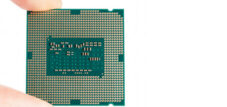[In collaboration with Kardex Remstar – ADVERTISEMENT]
The initial situation for storing SMD reels can be described as follows:
The customer stores a large quantity of SMD reels in their warehouse system. Picking these reels is then carried out in conjunction with the company's warehouse management system.
1. Delivery
The process begins when the manufacturer receives an order for electronic circuit boards, at which point the required number of SMD components is calculated. These are either already in stock or need to be ordered separately. Based on this information, the expected production date is determined. Shortly before this date, the ERP system performs a final automated check to ensure that all components are indeed in stock.
Problems:
SMD components are mostly manufactured in Asia. Due to the long transport distances, longer stock levels are often necessary.
There are different formats of the reels onto which the SMD components are glued. Their diameters can vary between 7 and 22 inches, and their widths range from under 10 to over 200 millimeters. Depending on this, they can be stored side by side, on top of each other, or one behind the other. This necessitates a flexible storage system
- the shelf height, in order to also ensure access to rolls stored in two rows
- the width of the brackets in shelves for the various formats
- special requirements (storage of sensitive SMD components in drying cabinets)
2. Storage
SMD reels can be stored in various ways. The most important thing is to store the components in a way that prevents electrostatic charging and thus avoids damage.
An increasingly important problem is the growing number of moisture-sensitive components. It is therefore essential to prevent any potential moisture ingress and the resulting increased likelihood of component damage during the soldering process. This risk can be mitigated by proper storage in drying cabinets or by using a modified and controlled atmosphere within the storage systems.
During storage, the incoming rolls are scanned and stored in the ERP system with information such as delivery time, order and material data, etc.
Based on the number of printed circuit boards produced, one can assume two different groups and requirement profiles for SMD handling:
- Producers of high volumes with short inventory lead times can more easily access standard solutions for warehouse technology and software than
- Producers of small series and prototypes. Due to the often small production runs, they face the challenges of more complex warehousing:
- Only standard components are kept in stock for SMD reels. Other SMD components are only ordered once an order is received
- These SMD components are only stored temporarily
- The increased warehouse complexity results in higher demands on order picking and ERP systems
3. Provision
If all components required for a production order are available in stock, the order-related picking process can begin
SMD reels are ordered via the ERP system as soon as they are needed for production. The reels are retrieved from the warehouse, taken from the shelves/racks, and then manually loaded onto the feeders. This is a standard procedure in which the retrieval of the reels is separate from the mounting process on the feeders. Manual intervention is necessary here because threading the SMD tapes is currently difficult to automate. The feeders are then transported to the production areas and positioned accordingly.
Another approach is the simultaneous removal and assembly of the rolls onto the feeders, which leads to significant time and therefore cost savings, but requires a higher degree of automation in warehousing and therefore higher investment costs.
The SMD reels can also be automatically removed from the trays and transported for further processing. There, they are manually placed on the feeders and made available.
Once the SMD components are ready for production, robots pick them from the reels and solder them onto the circuit boards. The components are removed using vacuum pipettes or grippers and then placed and soldered onto the circuit board. This process is repeated for all components. After the circuit board is fully populated, it is replaced with the next one. If necessary, the circuit boards receive a protective coating after this process. The fully assembled circuit boards then undergo various tests and functional checks.
4. Restoration
Once the process is complete, the ERP system provides detailed information about
- used
- dropped (mistakes) or
- damaged SMD
This process is called "back flushing". The remaining quantities are now recorded in detail in the ERP system. Afterwards, the SMD reels are..
- stored again
- transported to the next production apparatus
- scrapped

